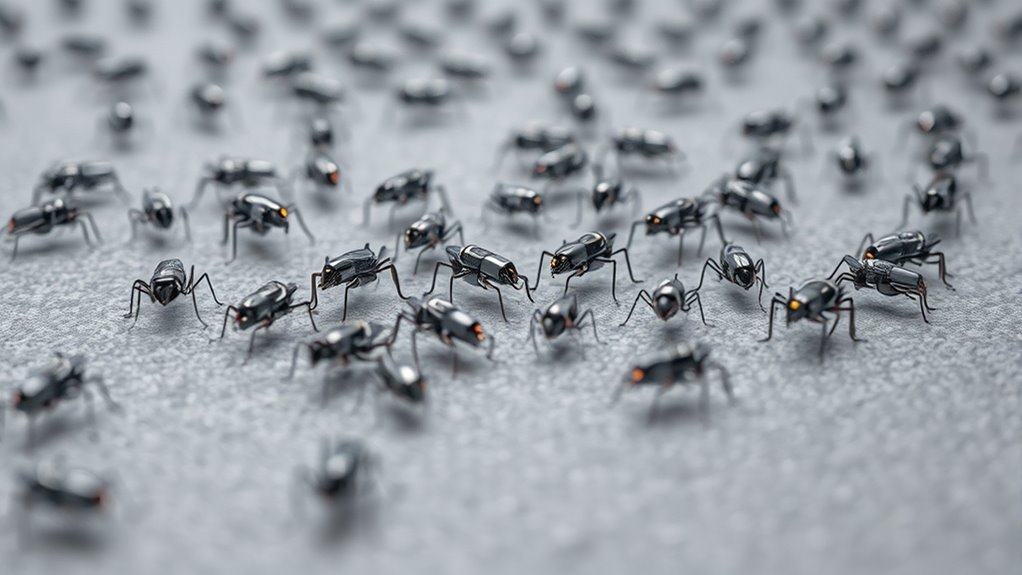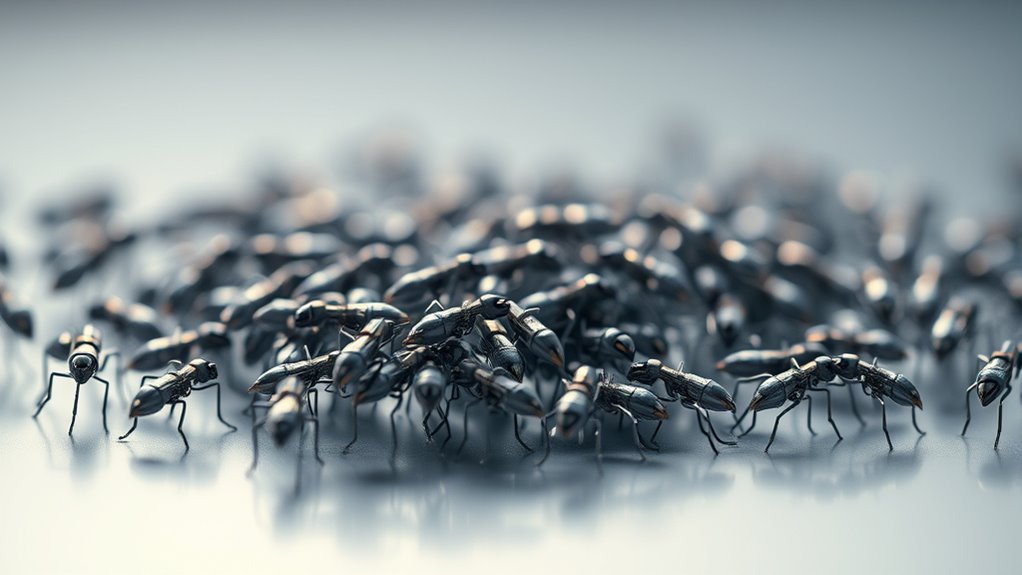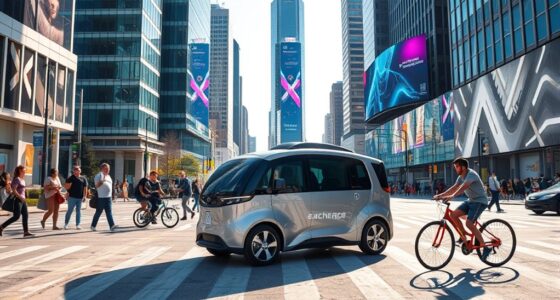Swarm robotics involves tiny, simple robots working together without central control, much like ants or bees. These bots coordinate through local interactions, sensors, and signals, enabling complex behaviors that emerge from their collective actions. They can adapt, be resilient, and tackle tasks like exploration or search and rescue. As you explore further, you’ll discover how scientists are constantly improving algorithms to make these swarms smarter and more effective.
Key Takeaways
- Swarm robotics involves many simple robots working together through decentralized rules, mimicking ant colony behaviors.
- Robots communicate locally using sensors, signals, or shared rules to coordinate actions.
- Emergent behaviors arise from individual interactions, enabling complex tasks without central control.
- This approach offers robust, cost-effective solutions for exploration, search and rescue, and environmental monitoring.
- Advances in algorithms inspired by natural systems enhance swarm adaptability, resilience, and collective problem-solving.

Swarm Robotics
Have you ever wondered how large groups of simple robots can coordinate to perform complex tasks? It’s a fascinating area of robotics called swarm robotics, where many tiny bots work together seamlessly, mimicking the behavior of social insects like ants or bees. Unlike traditional robots that rely on centralized control, swarm robotics depends on decentralized systems, where each robot operates based on local information and simple rules. This setup leads to a remarkable phenomenon known as emergent behavior, where complex, coordinated actions arise from the interactions of individual units without any single robot directing the entire group. It’s this emergent behavior that makes swarm robotics so powerful and adaptable for a wide range of applications.
Large groups of simple robots coordinate seamlessly through decentralized rules, creating complex behaviors without central control.
In swarm robotics, robot coordination is achieved through simple communication methods and shared rules. Each robot reacts to its immediate environment and to signals from nearby robots, often using sensors, light, or sound. They don’t need detailed instructions; instead, they follow basic behaviors like moving toward a target, avoiding obstacles, or following neighbors. These local interactions, when combined across hundreds or thousands of robots, produce sophisticated collective behavior. For example, if some robots detect a resource or danger, they can signal others, leading the entire group to respond appropriately. This decentralized coordination allows the swarm to adapt quickly to changes and operate efficiently even in unpredictable environments. Additionally, researchers are exploring how collective intelligence can be harnessed through these systems to solve complex problems.
Emergent behavior is at the core of what makes swarm robotics so intriguing. It’s the spontaneous organization that occurs when individual robots follow simple rules, yet the overall system displays intelligence and functionality. Think of how ants find the shortest path to food or how flocks of birds change direction in unison—these are natural examples of emergent behavior. In robotics, the same principle applies: no single robot controls the entire swarm, but through local interactions, the group can perform tasks like exploration, mapping, search and rescue, or environmental monitoring. The beauty of emergent behavior is that it scales well; adding more robots often enhances performance rather than causing chaos. Furthermore, advancements in robotic algorithms continue to improve the complexity and effectiveness of these emergent behaviors, making the field even more promising. For example, evolving algorithms inspired by natural systems can lead to more adaptive and resilient swarm behaviors.
This approach offers significant advantages. Swarm robots are typically inexpensive, easy to replace, and robust against individual failures. If a few robots break down, the rest keep functioning without disruption. Their ability to self-organize makes them suitable for tasks in hazardous or inaccessible environments. Researchers are continually refining algorithms for robot coordination to enhance the complexity and efficiency of emergent behaviors. As a result, swarm robotics holds the promise of revolutionizing fields like agriculture, disaster response, and space exploration, where large-scale cooperation is essential. You’re witnessing a future where tiny bots, working together through simple rules, can accomplish extraordinary feats through the power of emergent behavior.
Frequently Asked Questions
How Do Swarm Robots Communicate With Each Other?
You can think of swarm robots communicating through sensor networks, which allow them to share information locally. They send signals or data to nearby bots, enabling coordination. This decentralized communication leads to emergent behavior, where simple actions by individual robots result in complex group activities. By exchanging signals efficiently, they adapt and work together seamlessly, mimicking natural systems like ant colonies to complete tasks effectively.
What Are the Main Challenges in Developing Swarm Robotics?
You’re tackling a monumental challenge in developing swarm robotics, where managing countless tiny units seems like controlling a particle swarm of chaos. The main hurdles include designing algorithms that promote emergent behavior without centralized control, ensuring reliable communication among bots, and scaling systems efficiently. Overcoming these issues requires innovative strategies, but the potential for creating self-organizing, adaptive robotic teams makes it an exciting frontier worth pursuing.
Can Swarm Robotics Adapt to Unpredictable Environments?
You can see that swarm robotics can adapt to unpredictable environments through bio-inspired algorithms that enable emergent behavior. By mimicking nature, these systems allow individual robots to respond flexibly to changes without central control. This decentralized approach helps the swarm coordinate effectively, even when facing unexpected challenges. As a result, your swarm can dynamically adjust, making it well-suited for complex, unpredictable situations.
What Industries Are Most Likely to Benefit From Swarm Robotics?
You might find that industries like agriculture, logistics, and disaster response benefit most from swarm robotics. These fields leverage distributed algorithms and collective intelligence to tackle complex tasks efficiently, even in unpredictable environments. The ability for small robots to work together, adapt, and make decisions collectively can revolutionize how we approach farming, search and rescue, or warehouse management, making processes faster, safer, and more cost-effective.
How Do Individual Robots Coordinate Without Central Control?
You might wonder how individual robots coordinate without central control. They rely on sophisticated robotic algorithms within decentralized systems, enabling each bot to make decisions based on local information and simple rules. This approach allows the swarm to adapt, organize, and complete tasks collectively. By communicating directly or indirectly, the robots work seamlessly, mimicking natural behaviors like ant colonies, without needing a central command, ensuring efficiency and robustness in various applications.
Conclusion
Imagine controlling a hundred tiny robots working seamlessly like ants, each contributing to a larger goal. Studies show that swarm robotics can complete tasks 30% faster than individual robots working alone. This incredible efficiency demonstrates how simple units can create complex, intelligent systems. As you see these tiny bots collaborate effortlessly, it’s clear that swarm robotics holds the potential to revolutionize fields from search-and-rescue to environmental monitoring. The future is bright with these tiny, united explorers leading the way.









